Arms
  |
|
Baron Rathcreedan, of Bellehatch Park in the County of Oxford, is a title in the Peerage of the United Kingdom. [1] It was created 27 January 1916 for the Liberal politician Cecil Norton. He had previously represented Newington West in the House of Commons and served as a Junior Lord of the Treasury from 1905 to 1910 and as Assistant Postmaster-General between 1910 and 1916. Since 1990, the title is held by his grandson, the third Baron. [2]
The heir presumptive is the present holder's brother the Hon. Adam Gregory Norton (b. 1952). There are no other heirs to the title.
  |
|

Marquess of Exeter is a title that has been created twice, once in the peerage of England and once in the peerage of the United Kingdom. The first creation came in the peerage of England in 1525 for Henry Courtenay, 2nd Earl of Devon. For more information on this creation, which was forfeited in 1538, see Earl of Devon.
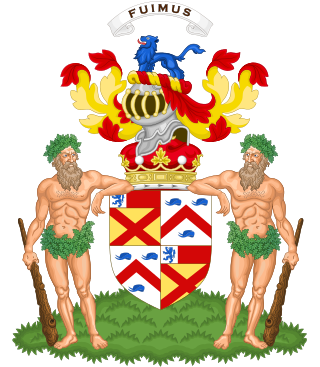
Marquess of Ailesbury, in the County of Buckingham, is a title in the Peerage of the United Kingdom. It was created on 17 July 1821 for Charles Brudenell-Bruce, 2nd Earl of Ailesbury.

Baron Byron, of Rochdale in the County Palatine of Lancaster, is a title in the Peerage of England. It was created in 1643 by letters patent for Sir John Byron, a Cavalier general and former Member of Parliament. The peerage was created with remainder to the heirs male of his body, failing, to his six brothers: Richard, William, Thomas, Robert, Gilbert, and Philip, and the heirs male of their bodies. Lord Byron died childless and was succeeded according to the special remainder by his next eldest brother Richard, the second Baron.

Viscount Dilhorne, of Greens Norton in the County of Northampton, is a title in the Peerage of the United Kingdom. It was created on 7 December 1964 for the lawyer, Conservative politician and former Lord Chancellor, Reginald Manningham-Buller, 1st Baron Dilhorne. He had already succeeded his father as fourth Baronet of Dilhorne and been created Baron Dilhorne, of Towcester in the County of Northampton on 17 July 1962, also in the Peerage of the United Kingdom.
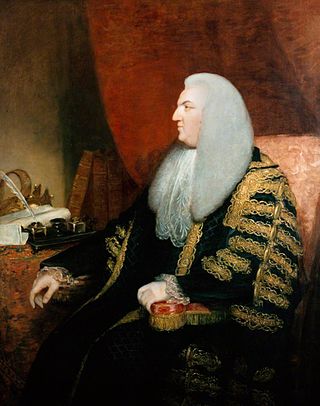
Baron Grantley, of Markenfield, in the County of York is a title in the Peerage of Great Britain. It was created on 9 April 1782 for Sir Fletcher Norton, Attorney General from 1763 to 1765 and Speaker of the House of Commons from 1770 to 1780. His son, the second Baron, was also a politician and represented Richmond, Wigtown Burghs, Guildford and Surrey in Parliament. He was succeeded by his nephew, Fletcher Norton, the third Baron. He was childless and on his death the title passed to his nephew, the fourth Baron. As of 2017 the title is held by the latter's great-great-grandson, the eighth Baron, who succeeded his father in 1995.
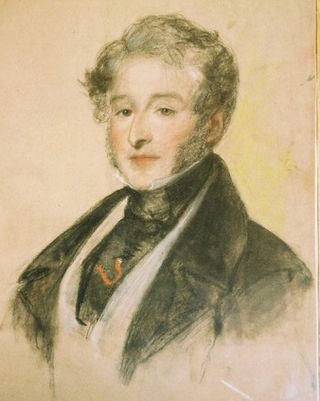
Baron Dinevor, of Dinevor in the County of Carmarthen, is a title in the Peerage of Great Britain. It was created on 17 October 1780 for William Talbot, 1st Earl Talbot, with remainder to his daughter, Lady Cecil, wife of George Rice, a member of a prominent Welsh family. On Lord Talbot's death the earldom became extinct because he left no sons to succeed to it, while the barony of Talbot also held by him was inherited by his nephew. The barony of Dynevor passed according to the special remainder to his daughter, the second holder of the title. In 1787 Lady Dynevor assumed by Royal licence the surname of de Cardonnel in lieu of Rice.

Baron Ashtown, of Moate in the County of Galway, is a title in the Peerage of Ireland. It was created in 1800 for Frederick Trench, with remainder to the heirs male of his father.

Baron Hardinge of Penshurst, in the County of Kent, is a title in the Peerage of the United Kingdom. It was created in 1910 for the diplomat the Hon. Sir Charles Hardinge, Viceroy and Governor-General of India from 1910 to 1916. He was the second son of Charles Hardinge, 2nd Viscount Hardinge. His son, the second Baron, served as private secretary to both King Edward VIII and King George VI.

Baron Glenarthur, of Carlung in the County of Ayr, is a title in the Peerage of the United Kingdom. It was created in 1918 for the Scottish businessman Sir Matthew Arthur, 1st Baronet. He had already been created a baronet, of Carlung in the County of Ayr, on 28 November 1902. The title of the barony was derived from the joining of his mother's maiden surname name of Glen and his patronymic Arthur.
Baron Addington, of Addington in the County of Buckingham, is a title in the Peerage of the United Kingdom. It was created on 22 July 1887 for the businessman and Conservative Member of Parliament, John Hubbard. He was head of the firm of John Hubbard & Co and also sat as a Member of Parliament for Buckingham and the City of London. His eldest son, the second Baron, was a partner in the family firm and represented Buckingham in the House of Commons as a Conservative. He was succeeded by his eldest son, the third Baron. He was three times Mayor of Buckingham. On the death of his younger brother, the fourth Baron, the line of the eldest son of the first Baron failed. The title passed to their first cousin once removed, the fifth Baron. He was the grandson of Cecil John Hubbard, third son of the first Baron. As of 2018, the title is held by his eldest son, the sixth Baron. He is one of the ninety elected hereditary peers that remain in the House of Lords after the passing of the House of Lords Act of 1999. Lord Addington sits on the Liberal Democrat benches.
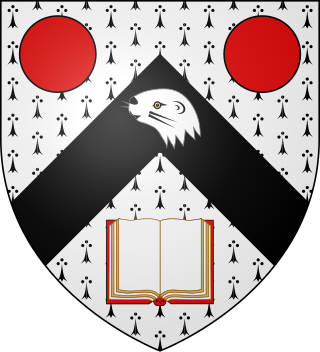
Baron Kinross, of Glasclune in the County of Haddington, is a title in the Peerage of the United Kingdom. It was created on 15 July 1902 for Scottish lawyer John Balfour, Liberal politician and Lord President of the Court of Session. His grandson, the third baron, was an author and journalist. As of 2019 the title is held by the latter's nephew, the fifth baron, who succeeded his father in 1985.
Baron Norton, of Norton-on-the-Moors in the County of Stafford, is a title in the Peerage of the United Kingdom. It was created in 1878 for the Conservative politician and former President of the Board of Trade, Sir Charles Adderley. He was succeeded by his elder son, the second Baron. Two of his sons, the third and fourth Baron, both succeeded in the title. On the latter's death in 1944, the title passed to his eighty-nine-year-old uncle, the fifth Baron.

Baron Newall, of Clifton-upon-Dunsmoor in the County of Warwick, is a title in the Peerage of the United Kingdom. It was created on 18 July 1946 for Marshal of the Royal Air Force Sir Cyril Newall. He was Chief of the Air Staff between 1937 and 1940 and Governor-General of New Zealand between 1941 and 1946. As of 2017 the title is held by his only son, the second Baron, who succeeded in 1963.
Baron Palmer, of Reading in the County of Berkshire, is a title in the Peerage of the United Kingdom. It was created in 1933 for the businessman and patron of music, Sir Ernest Palmer, 1st Baronet. He had already been created a baronet, of Grosvenor Crescent in the City of Westminster, in the Baronetage of the United Kingdom on 26 January 1916. The Palmer family had made its fortune from their ownership of the firm of Huntley & Palmers, biscuit manufacturers, of Reading. As of 2023 the titles are held by the first Baron's great-great-grandson, the fifth Baron, who succeeded his father in 2023.

Baron Beaverbrook, of Beaverbrook in the Province of New Brunswick in the Dominion of Canada and of Cherkley in the County of Surrey, is a title in the Peerage of the United Kingdom. It was created in 1917 for the prominent media owner and politician Sir Max Aitken, 1st Baronet. He had already been created a baronet, of Cherkley in the County of Surrey, on 3 July 1916. When Aitken died, his son disclaimed the barony three days later, stating that "there shall only be one Lord Beaverbrook in my lifetime". Since 1985, the title has been held by the latter's son, the third Baron.

Baron Chesham, of Chesham in the County of Buckingham, is a title in the Peerage of the United Kingdom created in 1858 for the Hon. Charles Cavendish, who had earlier represented Aylesbury, Newtown, East Sussex, Youghal and Buckinghamshire in the House of Commons as a Liberal.

Baron Rothschild, of Tring in the County of Hertfordshire, is a title in the Peerage of the United Kingdom. It was created in 1885 for Sir Nathan Rothschild, 2nd Baronet, a member of the Rothschild banking family. He was the first Jewish member of the House of Lords not to have previously converted to Christianity. The current holder of the title is Jacob Rothschild, 4th Baron Rothschild, who inherited the barony in 1990.
Baron Rockley, of Lytchett Heath in the County of Dorset, is a title in the peerage of the United Kingdom. It was created on 11 January 1934 for the Conservative politician Sir Evelyn Cecil, who had earlier represented Hertfordshire East, Aston Manor and Birmingham Aston in the House of Commons. He was the son of Lord Eustace Cecil, fourth son of James Gascoyne-Cecil, 2nd Marquess of Salisbury. The first baron was married to the horticulturist Alicia Amherst. As of 2019 the title is held by their great-grandson, the fourth baron, who succeeded his father in 2011.
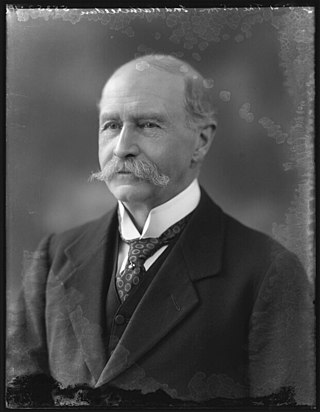
Cecil William Norton, 1st Baron Rathcreedan was a British Liberal Party politician.
The 1916 Newington West by-election was a parliamentary by-election held in England on 10 January 1916 to elect a new Member of Parliament (MP) for the House of Commons constituency of Newington West in South London.